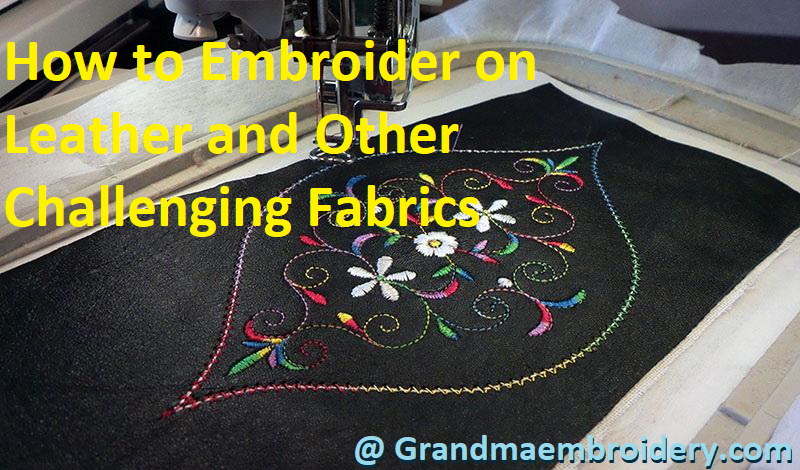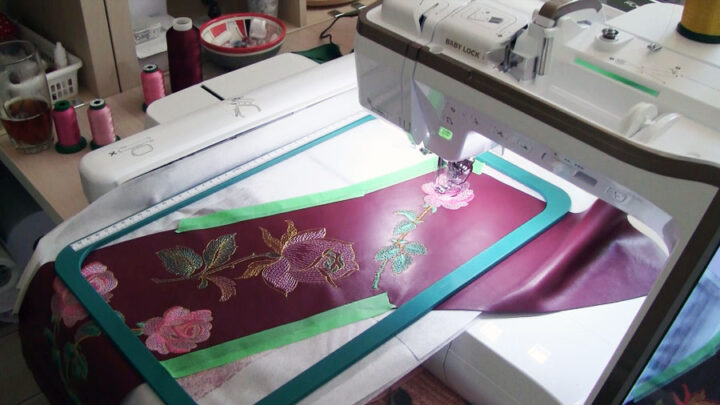Introduction
Embroidery is a form of needlework that involves decorating fabric with decorative stitches and patterns. While embroidery can be done on a variety of fabrics, certain materials can be more challenging to work with than others. In this article, we will explore the techniques and tools that can be used to embroider on challenging fabrics such as leather, velvet, and silk.

We will discuss the importance of choosing the right embroidery design, stabilizers, needles, and threads for each fabric type, as well as offer tips for achieving the best results. Whether you’re an experienced embroiderer looking to expand your skills or a beginner looking to take on a new challenge, this article will provide you with the knowledge and resources to embroider on even the most difficult fabrics.
Choosing the Right Tools and Materials
Embroidering on challenging fabrics such as leather, velvet, and silk requires specialized tools and materials to achieve the best results. The choice of needles, threads, and stabilizers is particularly important in ensuring that the embroidery looks neat, stays in place, and does not damage the fabric.
Needles for embroidery on leather and other heavy fabrics should be sharp and sturdy. It is recommended to use a needle with a large eye to accommodate thicker threads, such as a chenille needle. For finer fabrics like silk, a sharp needle with a smaller eye is recommended.
Thread selection is also crucial in achieving the desired look and ensuring that the embroidery stays in place. For leather, a heavy-duty polyester or nylon thread is recommended, while for velvet and silk, a finer silk or cotton thread is more appropriate.
Stabilizers are used to support the fabric during embroidery and prevent distortion. For leather, a tear-away stabilizer is ideal as it can be easily removed after embroidery is complete. For velvet and silk, a water-soluble stabilizer is recommended as it dissolves when exposed to water and does not leave any residue.
It is important to use appropriate tools and materials when embroidering on challenging fabrics as this can make a significant difference in the final result. By choosing the right needles, threads, and stabilizers, the embroidery will look professional and remain in good condition over time.
III. Preparing the Fabric
Preparing the fabric is an important step in achieving successful embroidery on challenging fabrics. Here are some tips to consider:
Cleaning and conditioning: Before starting embroidery, it is important to clean the fabric and remove any dirt or debris that may be present. This is particularly important for leather, which can be sensitive to oils and dirt. To clean leather, use a damp cloth and mild soap, taking care not to saturate the material. For velvet and silk, it is best to dry clean the fabric prior to embroidery. Conditioning the fabric with a leather or fabric conditioner can also help to soften and protect the material.

Stabilizing the fabric: Stabilizers are essential when embroidering on challenging fabrics, as they help to prevent distortion and ensure that the embroidery stays in place. When selecting a stabilizer, it is important to consider the weight and texture of the fabric. For leather, a tear-away stabilizer should be used to support the material during embroidery. For velvet and silk, a water-soluble stabilizer is recommended to prevent any damage to the delicate fabric. It is also important to test the stabilizer on a small area of the fabric before starting the embroidery to ensure that it does not cause any damage or staining.
Hooping the fabric: Hooping is the process of securing the fabric and stabilizer in an embroidery hoop to keep the fabric taut during embroidery. When hooping challenging fabrics, it is important to take care not to stretch or distort the material. To prevent this, use a larger hoop that can accommodate the fabric without pulling it tight.
By taking the time to properly prepare the fabric for embroidery, you can ensure that the final result is both beautiful and long-lasting. Proper cleaning, conditioning, and stabilizing of the fabric will help to prevent damage and ensure that the embroidery looks neat and professional.
Designing the Embroidery
When designing embroidery for challenging fabrics such as leather, velvet, and silk, it is important to consider a few key factors to ensure that the final result is both visually appealing and structurally sound.
Choosing the right colors and motifs: When selecting colors for embroidery on challenging fabrics, it is important to choose colors that will stand out against the fabric. For example, if embroidering on a dark leather, light-colored thread may be more effective in highlighting the design. When selecting motifs, consider designs that are simple and not too intricate, as they will be easier to execute on challenging fabrics.
Transferring the design onto the fabric: There are several techniques for transferring embroidery designs onto fabric, including tracing the design onto the fabric, using a transfer pencil or pen, or using a transfer paper. When working with challenging fabrics, it is important to choose a transfer method that will not damage the fabric or leave any marks. For example, using a transfer pencil or pen can be effective for leather, while transfer paper may work well for velvet and silk.
Once the design has been transferred onto the fabric, it is important to ensure that it is properly positioned and centered. This can be done by measuring and marking the fabric or by using a template.
By carefully considering design elements and using appropriate transfer techniques, you can create beautiful and structurally sound embroidery on challenging fabrics.
Embroidering on Challenging Fabrics
Embroidering on challenging fabrics such as leather, velvet, and silk requires a different approach than embroidery on traditional fabrics. Here are some techniques to consider when embroidering on challenging fabrics:
Stitching techniques: When embroidering on challenging fabrics, it is important to use appropriate stitching techniques to ensure that the embroidery looks neat and professional. For leather, a backstitch or running stitch is recommended, as it creates a clean and sturdy line. For velvet and silk, a satin stitch or split stitch can be effective, as they create a smooth and even finish.
Managing tension: Tension is an important factor in embroidery, and it is particularly crucial when embroidering on challenging fabrics. It is important to adjust the tension on the machine or hoop to ensure that the thread is not too loose or too tight. This can help to prevent puckering or distortion of the fabric.
Troubleshooting common problems: Even with proper preparation and technique, embroidery on challenging fabrics can sometimes present problems such as puckering or skipped stitches. To prevent puckering, ensure that the fabric is properly stabilized and use a larger hoop to prevent distortion. To prevent skipped stitches, use a sharp needle and adjust the tension on the machine or hoop.
By using appropriate stitching techniques and managing tension, you can create beautiful and structurally sound embroidery on challenging fabrics. If problems do arise, there are a number of troubleshooting techniques that can help to prevent damage to the fabric and ensure that the final result looks neat and professional.
Finishing Touches
Once the embroidery is complete, there are a few final steps to take to ensure that the final result looks its best and lasts for a long time:
Removing stabilizers: Once the embroidery is complete, it is important to remove any stabilizers that were used during the stitching process. This can be done by carefully tearing away the excess stabilizer or by rinsing it away with water.
Protecting the embroidery: Embroidery on challenging fabrics such as leather and velvet can be vulnerable to damage from wear and tear, sunlight, and moisture. To protect the embroidery, consider using a leather protectant or fabric spray to help repel moisture and prevent fading. It is also important to avoid placing the embroidered item in direct sunlight or exposing it to excessive moisture.

Finishing touches: Once the stabilizers have been removed and the embroidery has been protected, the final step is to trim any loose threads and inspect the embroidery for any final touches. This may include adding additional stitches or embellishments to reinforce the design or create additional visual interest.
Caring for embroidered items: To ensure that embroidered items last for a long time, it is important to care for them properly. This may include spot cleaning as needed, avoiding excessive rubbing or abrasion, and storing items in a cool, dry place away from direct sunlight.
By taking the time to properly finish and care for embroidered items, you can ensure that they look their best and last for years to come.
VII. Conclusion
Embroidering on challenging fabrics such as leather, velvet, and silk requires careful preparation, appropriate tools and materials, and a different approach to stitching and design. To summarize the main points of the article:
Choosing the right tools and materials is essential for optimal results.
Preparing the fabric properly, including cleaning and conditioning, and stabilizing it appropriately, can help to prevent puckering and distortion.
When designing the embroidery, consider using simple motifs and choosing colors that will stand out against the fabric. Use appropriate transfer techniques to ensure that the design is properly positioned and centered.
When embroidering on challenging fabrics, use appropriate stitching techniques and manage tension to prevent puckering and skipped stitches.
Once the embroidery is complete, remove any stabilizers, protect the embroidery from damage, and trim loose threads. Care for embroidered items properly to ensure that they last for years.
Embroidering on challenging fabrics can be a rewarding and creative experience. While it may require some additional effort and care, the final results can be stunning and unique. We encourage readers to try embroidering on challenging fabrics and experiment with different techniques to create beautiful and memorable pieces.
See Also-
- Best Embroidery Machine For Small Business 2023
- Best Affordable Embroidery Machine 2023
- Best Embroidery Machine For Patches 2023
- Best Commercial Embroidery Machine 2023
- Best Embroidery Machine For Clothing 2023
